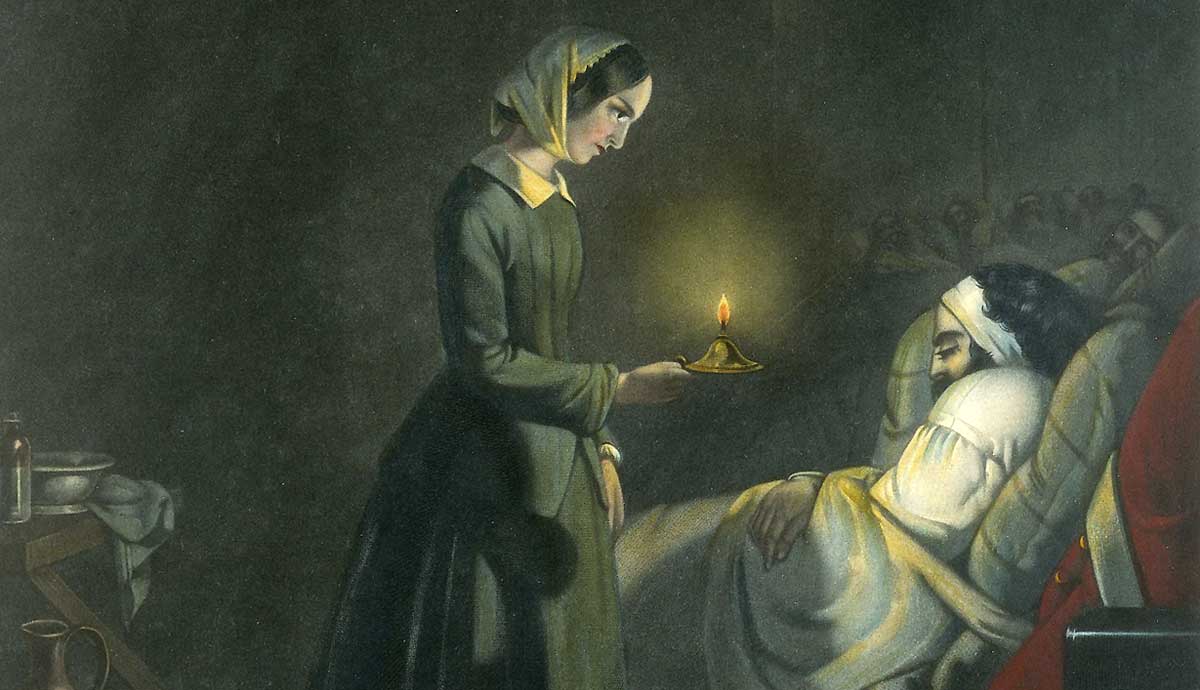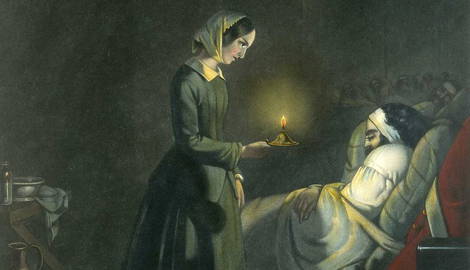
Nicknamed the “Lady with the Lamp,” Florence Nightingale had a lasting effect on ill and injured soldiers and gained a reputation that made her famous across the continent. She had a profound impact on the history of nursing and, in this vein, set the way for future women who wanted to pursue a nursing career in a world that was not accepting of women doing so.
Early Life of Florence Nightingale

Florence was born in May 1820 in the Italian city that shares her name. She had two older siblings, and her family belonged to the elite British social circles. Her mother was Frances Nightingale, and her father was William Shore Nightingale.
Frances Nightingale came from a family of wealthy merchants. She was interested in climbing the social ladder, a pursuit in which she schooled her children. However, this was something that Florence rejected entirely and would become a struggle between the two women.
William Shore Nightingale, her father, was a wealthy landowner. He had inherited not one but two estates (Lea Hurst in Derbyshire and Embley Park in Hampshire). Lea Hurst was where Florence and her siblings were raised and where they were provided with a good education. She was taught German, French and Italian.

Even from a young age, Florence was interested in helping people, something out of which she would end up making a career. She was involved in philanthropy and would help the ill and poor in her local village. When she was just 16, Florence decided she wanted to be a nurse. She was so sure this was her purpose that she believed it was a calling from God.
However, in the nineteenth century, it was not normal for women of Florence’s social standing to work, especially not a career associated with the poor. Because of this, her parents forbade Florence from pursuing her career.
Florence angered her parents even more just a year later when she refused the marriage proposal of a gentleman who her parents saw as suitable. The man’s name was Richard Monckton Milnes.
Eventually, Florence got the opportunity to pursue her career despite her parent’s objections. She enrolled as a student nurse at the Lutheran Hospital in Kaiserwerth, Germany in 1844.
Florence Nightingale’s Early Career

After her training in Germany in the 1850s, Florence returned to England and found a job working in a hospital for gentlewomen in Middlesex. Within just a year of getting the job, Florence was promoted to superintendent because she impressed her superiors so much.
The job was not easy. Florence was faced with a cholera outbreak as well as unsanitary conditions, which only made the spread of the disease worse. Despite the dangers, Florence set about improving the conditions of the hospital. As the hygiene of the place got better, deaths decreased.
Florence Goes to War

Everything changed, however, in October of 1853 when the Crimean War broke out. The British went to war with Russia for control over the Ottoman Empire. Thousands of soldiers were sent over to fight, and conditions soon deteriorated.
There were not enough supplies, and by just 1854, there were about 18,000 soldiers in military hospitals. All the nurses and doctors working there were men, as women had not been permitted. However, after the Battle of Alma, conditions were so bad that the English public was furious, and the situation had to change.
In 1854, Secretary of War Sidney Herbert wrote to Florence requesting that she organize a group of nurses to travel to Crimea and help the soldiers there. Of course, Florence agreed and collected a number of female nurses from some religious orders and sailed to Crimea.

Despite the warnings and outcry, Florence and her nurses were horrified by what awaited them. Florence was based in a British hospital in Scutari in Constantinople. Unbelievably, the hospital sat atop a huge cesspool that was seeping into the hospital’s water.
Patients in the hospital lay in their own excrement, and it was so overcrowded that some lay on beds in the hallways. Rats ran around the hospital floors, and supplies were running extremely low. Despite this, soldiers kept flooding in at an alarming rate. It was so bad that even water was rationed!
One of the first and perhaps most overwhelming issues Florence faced was the fact that more soldiers were dying because of the disgusting conditions in the hospital than from their battle wounds. This was from diseases like typhoid and cholera, which could have been avoided with good hygiene measures.
A Transformation Takes Place

Florence saw it as her duty to transform the hospital. She set about collecting hundreds of cleaning supplies and recruited the ablest patients to help scrub the walls and floors of the hospital.
Florence also spent every moment she could helping the patients, even working long into the night. Her nickname “The Lady with the Lamp” comes from this. She would wander the halls of the hospital long after dark, holding a lamp and tending to patients.
Other soldiers nicknamed her the “Angel of Crimea” as the hospital’s death rates were reduced by two-thirds. Florence not only cleaned up the hospital and helped its patients, but she also improved the services there. She created a kitchen and a laundry to ensure that patients had clean linen, which would prevent the spread of disease.
In addition to this, she built classrooms and a library for the patients in order to provide entertainment and intellectual stimulation which had not been previously available.
After Crimea

Florence used what she saw and learned in Crimea to produce a report named Notes on Matters Affecting the Health, Efficiency and Hospital Administration of the British Army. This was a staggering 830-page long analysis of what she saw and the reforms she proposed to improve the conditions of other military hospitals.
Because of her report, the War Office established a Royal Commission for the Health of the Army in 1857. After this, Florence remained in Crimea for another year and a half. She then returned home to her childhood home of Lea Hurst. On her return home, she was met with a hero’s welcome, and Queen Victoria presented her with a brooch known as the “Nightingale Jewel.”
Florence did not stop there, however; she continued with her work. With the support of the Queen, Florence employed William Farr and John Sutherland, leading statisticians, to analyze the data on army mortality. They found that a horrifying 16,000 of the 18,000 deaths were from preventable diseases, not battle! Florence was then able to translate the data into a new visual format. It was this act that gained traction and bolstered her name even further.
She created what became known as a “Nightingale Rose Diagram” to show the Sanitary Commissions’ work. It demonstrated that their work decreased the death rate in a way that made the highly complicated data accessible to the everyday person. Because of this, she became the first female member of the Royal Statistical Society. She was also made an honorary member of the American Statistical Association.
Florence Nightingale’s Death & Legacy

Again, Florence did not stop here. She continued her work by dedicating some of her money to the cause. In 1860, she funded the building and setting up of St Thomas’ Hospital. With this, she also set up the Nightingale Training School for Nurses.
Unfortunately, while in Crimea, Florence contracted Crimean Fever, from which she would never fully recover. Sadly, by the age of just 38, she was almost entirely bedbound. She continued to work on her writing from her bed in Mayfair, but she could never work practically again. She remained an advocate for health care and even interviewed politicians from her bed. In 1859, she published another work entitled Notes on Hospitals which discussed the best way to run civilian hospitals.
She was also consulted about military hospitals in America during the Civil War. She also served as the authority on sanitation issues in India, despite never having been to India herself. In 1908 at the age of 88, King Edward gave her the merit of honor.
In August 1910, Florence fell ill, and on Saturday, August 13th, she passed away at her home in London. Her relatives turned down a national funeral, and Florence was laid to rest in Hampshire, England. Today, in her memory, there is a Florence Nightingale Museum on the original site of her training school. It holds over 2,000 artifacts that tell of Florence’s life and experiences.
There is no doubt that Florence Nightingale made an incredible impact on nursing, not only in the number of lives she saved but also in the work she did to change ideas about women and work. She paved the way for hundreds of women after her to pursue careers, not just in nursing but in other sectors too.










